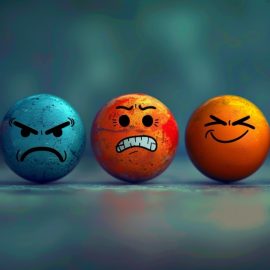

This article is an excerpt from the Shortform book guide to "The Righteous Mind" by Jonathan Haidt. Shortform has the world's best summaries and analyses of books you should be reading.
Like this article? Sign up for a free trial here .
How is morality determined by reason and emotion? Which force is stronger when it comes to ethics?
Some argue that morality is governed by reason. Others insist that morality is governed by emotion. In The Righteous Mind, social psychologist Jonathan Haidt discusses the argument, showing how philosophers and psychologists point to reason and emotion as driving forces behind our moral choices. He believes that one argument is stronger, and he offers insight into how we can leverage this to persuade others.
Read more to learn how reason and emotion come into play when it comes to our sense of right and wrong.
Reason and Emotion: The Rationalist Argument
An ancient truth, expressed by the Greek poets and philosophers, is that the mind can conflict with itself. Desire can pull you in one direction while reason pulls in another. As Plato expresses in Timaeus, feelings like pleasure, emotion, and even senses are necessary evils that separate us from reason, just like the neck separates the head from the body. Reason should be the master of emotion, even if it’s only the philosophers who can reach this mastery.
We can draw a line from Plato to Immanuel Kant to Lawrence Kohlberg—all great celebrators of reason. In the second half of the 20th century, this theory—that morality is based on reason—became particularly popular. Into the 60s and 70s, reformers at universities interested in promoting equality advanced the blank slate theory, the idea that at birth, everyone’s mind is a blank slate. If so, then everyone can learn to reason in the same way. If we could build a society that prioritized reason over all else, reformers argued, then we could do away with social problems like nativism and misogyny. People would be judged by the quality of their arguments alone, not by their gender, class, or race.
Reason and Emotion: The Counterargument
This sort of worshipful attitude is a rationalist delusion. Reason becomes so sacred that, like members of a cult, these thinkers can’t consider it clearly.
Haidt argues that, rather than being based on reason, moral judgment is intuitive, or emotional.
Think of intuition and reasoning like an elephant and its rider:
- The elephant (intuition) is huge and moves mostly on its own.
- Occasionally, though, the rider (reasoning) tries to guide it somewhere. This can be useful because, from the rider’s perch, it’s easier to see far into the future (or perform logical scenarios in our heads). The rider can also learn new technologies and skills, which can help the elephant get to its goals. Finally, the rider is the elephant’s spokesperson, even though the rider can’t always tell what the elephant is thinking.
Haidt conducted experiments to codify his theory of the elephant and the rider—he began by testing the theories of Thomas Jefferson and David Hume.
Jefferson vs. Hume
Two famous philosophers, David Hume and Thomas Jefferson, agreed that morality couldn’t be based entirely on reason. But they had slightly different interpretations of how reason and emotion (passion or intuition) interacted with one another. Hume argued that reason is slave to the passions, whereas Jefferson thought of reason and emotion as independent actors fighting with each other.
Haidt’s early thought was that, similar to Jefferson’s argument, reason and emotions like fear or sympathy could both lead to a moral judgment. He decided to test the role of reason in moral decision-making by asking people to make decisions in environments that made reasoning more or less difficult. For example, he had subjects make judgments while thinking of a large number that was hard to remember. Even in stressful cognitive conditions, though, people’s moral judgments didn’t change. Because reason was weakened and people still made strong moral judgments, this seemed to disprove Haidt’s original theory—perhaps reason wasn’t as necessary to morality as emotion.
Haidt then explored if reason could change a person’s moral judgment. He produced experiments that asked, would subjects change their minds when presented with someone challenging their immediate judgments?
- Haidt created an experiment with an undergrad that presented UVA students with a cup of apple juice to drink and asked them to take a sip. They all agreed to do so. Then, the undergrad dipped what he promised was a sterilized cockroach into the juice. 37% agreed to take a sip again, but of the majority who didn’t, the undergrad could only convince 10% to change their minds when presenting them with rational arguments about the sterilized cockroach. Most subjects wouldn’t change their minds because they were operating on gut feeling. Furthermore, they didn’t see any reason to justify their choice.
- Haidt then asked about a brother and a sister having sex with each other while both of them used protection. Only 20% said this was alright, and the 80% who didn’t generated many “logical” reasons why this wasn’t ok. They felt the need to justify their revulsion. People made a moral judgment immediately and emotionally, and they backed up their moral judgment with moral arguments. Even when Haidt or his assistants pointed out that if the brother and sister used protection they weren’t violating the harm principle, students refused to change their minds. These results supported Hume’s theory that reason is slave to the passions.
- When people saw the roaches and refused to eat them, they didn’t feel much need to justify their decision, because they felt it was simply a personal preference. However, when Haidt presented subjects with the idea of the brother and sister having sex, they saw this as a moral problem. Their intuition had already led most of them to the decision that the brother and sister shouldn’t be having sex. But they made a lot more post hoc arguments that were based on reason because they wanted other people to agree with their judgment.
Haidt, through this information, came up with the concept of the elephant and the rider and decided to change his model to a more Humean one, where it is mostly intuition that leads to moral judgment. He made the model more complex, where a triggering event leads to intuition, followed by judgment, and then reasoning to justify it.
Changing Minds
If people’s intuition leads, it’s not going to do much good to appeal to their reason when making arguments. To begin to change people’s minds, talk to the elephant. (Shortform note: To learn more about this concept, read our summary of Dale Carnegie’s How To Win Friends and Influence People.)
Even though we know it would be helpful to try to understand things from another’s point of view, most of us shift immediately into combat mode when trying to convince others of our righteousness. The rider and elephant can fend off attacks well—this shows our allies we are committed to our cause, but it won’t win anyone over, in particular if they shift into combat mode too. To change others’ minds, begin to practice empathy, even though it’s difficult to do so across a moral divide.
Understanding how reason and emotion influence our ethics can help us navigate our own choices—as well as our relationships with others.

———End of Preview———
Like what you just read? Read the rest of the world's best book summary and analysis of Jonathan Haidt's "The Righteous Mind" at Shortform .
Here's what you'll find in our full The Righteous Mind summary :
- Why we all can't get along
- How our divergent moralities evolved
- How we can counter our natural self-righteousness to decrease political divides






